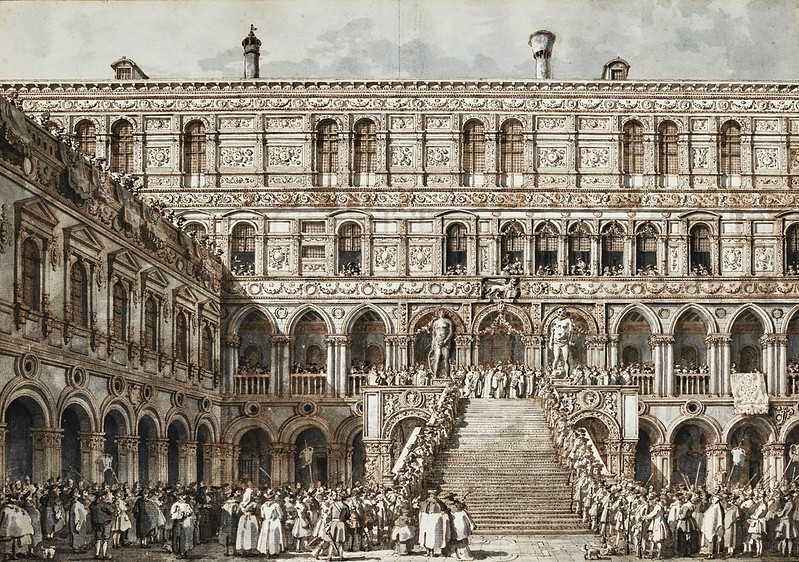Giacomo Antonio Perti (1661-1756)
- Messa detta 'La Lambertina' (1736)
Performers: Arion Choir; CoIIegio GhisIieri; GiuIio Prandi (conductor)
Drawing: Giovanni Antonio Canal 'Canaletto' (1697-1768) - Coronation of the Doge on the Scala dei Giganti
---
Italian composer. At the age of nine he began to study music in Bologna
with his uncle Lorenzo Perti and with Rocco Laurenti, from whom he
learnt the rudiments of organ playing. He started to study singing in
1670 and the year after he took up humanistic studies with the Jesuits
at S Lucia. In 1675 he began the study of counterpoint with his uncle
and he later studied with Petronio Franceschini. In 1678 his first music
to be performed, a mass, was given in S Tomaso al Mercato; two other
works, a motet and a Magnificat (both for eight voices), date from that
year. In 1679 he wrote his first operatic music – the third act of Atide
– and the oratorio S Serafia. In 1680 he wrote a Mass in D with two
trumpets (claimed by Martini to be the first of its kind), which was
performed in S Sigismondo. In 1681 he was admitted as composer to the
Accademia Filarmonica, where he was principe in 1687, 1693, 1697, 1705
and 1719, when he was made ‘diffinitore perpetuo’. Several months later
he went to Parma for further contrapuntal studies with Giuseppe Corso
(called Celano). Here, as is clear from a six-year correspondence with
Celano, he decisively formed his church music style, especially that of
the concerted masses and psalms of the 1680s and 90s. In 1688 he
published his first opus, Cantate morali e spirituali, dedicating it to
the Emperor Leopold I, who eventually rewarded him with a precious chain
of gold. In the following year he was in Venice, probably for the
production of his opera La Rosaura, and from there he applied for the
vacant position of vicemaestro di cappella of S Petronio. He was
unsuccessful, possibly because of the influence of G.P. Colonna, the
maestro di cappella (during the famous dispute over the consecutive 5ths
of Corelli, Perti had sided with Corelli against Colonna).
Perti was chosen to succeed his uncle Lorenzo as maestro di cappella of
the cathedral of S Pietro in 1690. In 1696 he was called from there to
be maestro di cappella of S Petronio, where he spent the rest of his
life, except for a few short journeys to Florence, Rome (1703 and 1747)
and Naples (1703). Simultaneously he held similar posts at S Domenico
(1704-55, G.M. Alberti deputizing for him from 1734) and the Madonna di
Galliera (1706-50). According to Martini he was offered a position at
the court of the Emperor Leopold I in 1697 in succession to Antonio
Draghi, but there is no other record of this. Because of financial
difficulties at S Petronio, Perti began his career there without a fixed
group of musicians. Until February 1701 musicians were hired only for
the required festive occasions. With the restoration of the cappella
musicale, however, the group was re-established with 24 regular
musicians. It was enlarged for festive occasions to as many as 153 in
1718 and 1719. In 1723 the regular group numbered 36, the highest number
during Perti’s term. Perti enjoyed considerable fame and favour with
several important personages, including Ferdinando III de’ Medici, for
whom he wrote church music and operas, which were staged at Pratolino,
and the Emperor Charles VI, to whom he dedicated his op.2. In 1740 the
emperor made him a royal councillor. His correspondence reveals a
long-standing rapport with the Duchess Aurora Sanseverino of Piedimonte
d’Alife, who was a member of a Bolognese family; he regularly sent
compositions to her for use at her court. His correspondence also
indicates that he was held in high regard by Fux, Caldara, Pasquini,
Corelli and other influential musicians. Padre Martini held him in the
highest esteem and included six examples of his contrapuntal music in
his Esemplare ossia Saggio fondamentale pratico di contrappunto
(1774–5). Among Perti’s students were Torelli, Gabrielli, Pistocchi,
Aldrovandini, P.P. Laurenti, G.B. Martini and F.O. Manfredini.

Cap comentari:
Publica un comentari a l'entrada